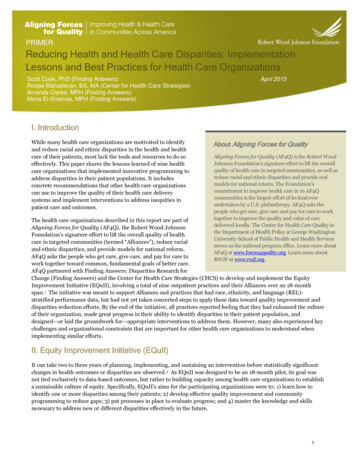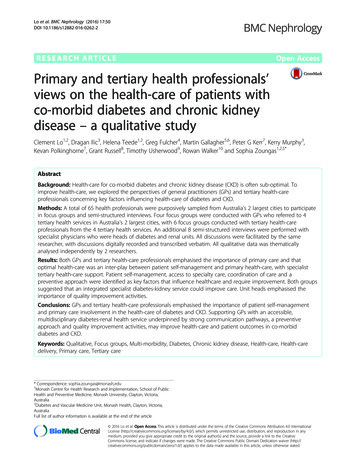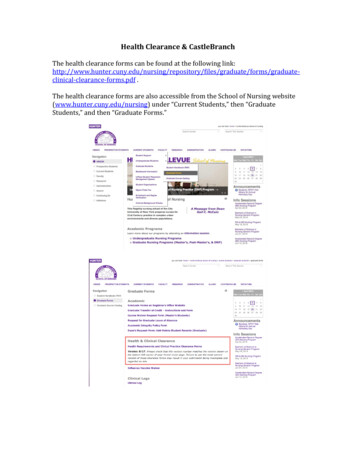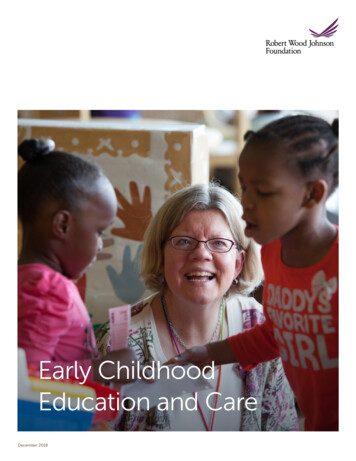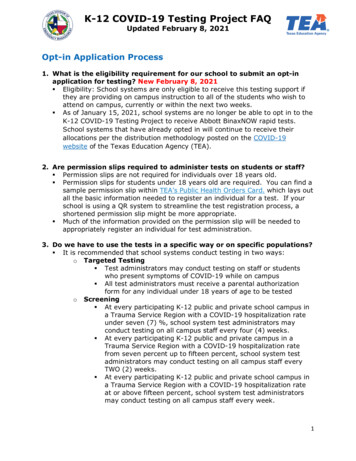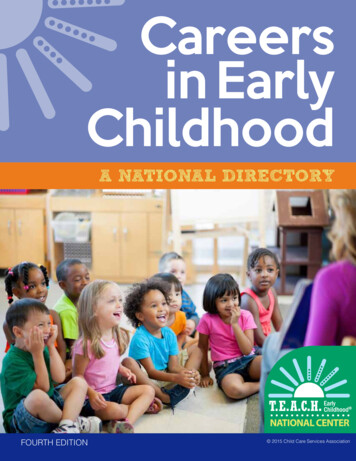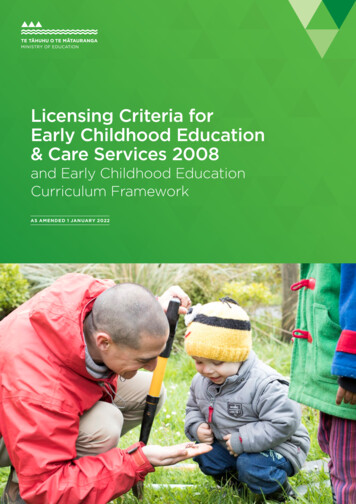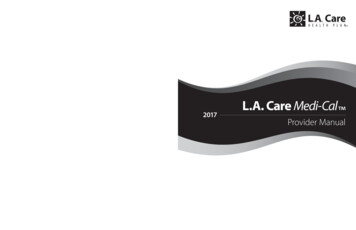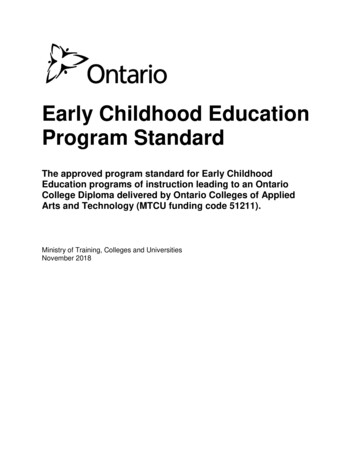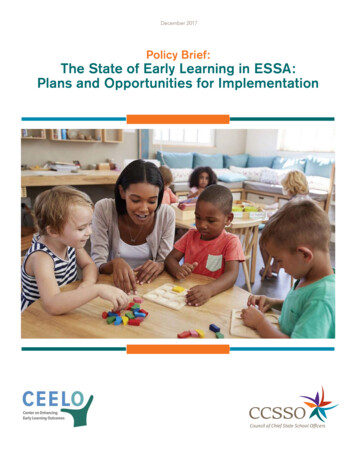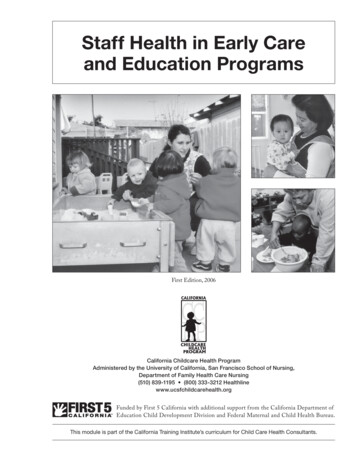
Transcription
Staff Health in Early Careand Education ProgramsFirst Edition, 2006California Childcare Health ProgramAdministered by the University of California, San Francisco School of Nursing,Department of Family Health Care Nursing(510) 839-1195 (800) 333-3212 Healthlinewww.ucsfchildcarehealth.orgFunded by First 5 California with additional support from the California Department ofEducation Child Development Division and Federal Maternal and Child Health Bureau.This module is part of the California Training Institute’s curriculum for Child Care Health Consultants.
AcknowledgementsThe California Childcare Health Program is administered by the University of California,San Francisco School of Nursing, Department of Family Health Care Nursing.We wish to credit the following people for their contributionsof time and expertise to the development and review of this curriculum since 2000.The names are listed in alphabetical order:Main ContributorsAbbey Alkon, RN, PhDJane Bernzweig, PhDLynda Boyer-Chu, RN, MPHJudy Calder, RN, MSLyn Dailey, RN, PHNRobert Frank, MSLauren Heim Goldstein, PhDGail D. Gonzalez, RNSusan Jensen, RN, MSN, PNPJudith Kunitz, MAMardi Lucich, MACheryl Oku, BAPamm Shaw, MS, EdDMarsha Sherman, MA, MFCCEileen Walsh, RN, MPHSharon Douglass Ware, RN, EdDRahman Zamani, MD, MPHAdditional ContributorsRobert Bates, Vella Black-Roberts, Judy Blanding, Terry Holybee, Karen Sokal-GutierrezOutside Reviewers, 2003 EditionJan Gross, RN, BSN, Greenbank, WAJacqueline Quirk, RN, BSN, Chapel Hill, NCAngelique M. White, RNc, MA, MN, CNS, New Orleans, LACCHP StaffEllen Bepp, Robin Calo, Catherine Cao, Sara Evinger, Joanna Farrer, Krishna Gopalan, Maleya Joseph, Cathy Miller,Dara Nelson, Bobbie Rose, Griselda Thomas, Kim To, Mimi WolffGraphic DesignersEdi Berton (2006), Eva Guralnick (2001-2005)We also want to thank the staff and Advisory Committee members of the California Childcare Health Programfor their support and contributions.California Childcare Health ProgramThe mission of the California Childcare Health Program is to improve the quality of child care by initiating andstrengthening linkages between the health, safety and child care communities and the families they serve.Portions of this curriculum were adapted from the training modules of the National Training Institute for Child Care HealthConsultants, North Carolina Department of Maternal and Child Health, The University of North Carolina at Chapel Hill; 2004-2005.Funded by First 5 California with additional support from the California Department of Education Child Development Divisionand Federal Maternal and Child Health Bureau.
LEARNING OBJECTIVESTo describe the major occupational hazards in early care and education (ECE) programs.To develop skills to implement measures which prevent and manage occupational hazards.To identify opportunities that promote staff health in the areas of nutrition and physical fitness.To describe three ways a Child Care Health Consultant (CCHC) can assist ECE programs indeveloping and implementing staff health and safety policies.To identify staff health and safety resources available to assist and support ECE providers andfamilies.WHY IS STAFF HEALTH IMPORTANT?ECE professionals are exposed to a wide variety of job-specific health and safety risks including: infectious disease, muskuloskeletal injuries, falls, environmental hazards, and stress. The health of ECE professionals impactsthe quality of care they are able to provide to children. Many health and safety policies in ECE programs protectchildren and adults, however, some safety issues specific to adult caregivers are often neglected. It is importantfor ECE providers to be aware of the OSHA regulations.Staff Health in ECE ProgramsnCalifornia Training InstitutenCalifornia Childcare Health Programn1
WHAT THE CCHCNEEDS TO KNOWThe CCHC needs to be aware of the many occupational health hazards that ECE professionals areexposed to. These hazards are outlined in Caring forOur Children: National Health and Safety PerformanceStandards: Guidelines for Out-of-Home Child CarePrograms, Second Edition (CFOC) (American Academy of Pediatrics [AAP], American Public HealthAssociation, & National Resource Center for Healthand Safety in Child Care, 2002) Appendix B andare reviewed here (see Handout: Major OccupationalHealth Hazards).Infectious DiseasesECE professionals acquire infectious diseases at ahigher rate than adults who have less contact withchildren (Holmes, Morrow, & Pickering, 1996; Reves& Pickering, 1992). The increased risk for ECE providers is attributed to the higher incidence of diseasein the population they work with (young children)and to children’s greater propensity for transmittingdiseases. Research examining the health effects ofout-of-home child care has produced convincing evidence that children attending ECE programs have ahigher incidence of common infectious diseases, andmore severe diseases, than children reared in theirown homes (Wald, Guerra, & Byers, 1991; Black etal., 1994; Holmes et al., 1996). Some of the diseasesproviders may contract from children are more serious when acquired by adults (e.g., Hepatitis A), andothers may have severe consequences for staff withcompromised immune systems or who are pregnant(e.g., cytomegalovirus [CMV]).Patterns of DiseaseIt is critical for CCHCs and ECE staff to be awareof the different patterns of infectious diseases thatmay occur in ECE programs. Respiratory and gastrointestinal tract infections are the most commonillnesses reported among children in ECE programs,and researchers believe these infections represent the2nStaff Health in ECE Programsnbulk of illnesses transmitted from children to ECEstaff (Cordell, 2001; Holmes et al., 1996).Not all diseases produce the same symptomaticresponse from staff and children alike. In some cases,such as Hepatitis A, children may be infected butshow no symptoms, while staff manifest a more serious response. Other diseases, such as H. influenzaetype b, may produce no apparent response in staff buta more severe response in children. Some diseases,such as CMV, may produce a mild or asymptomaticresponse in both the children and staff. However,CMV seriously affects the fetal development in previously uninfected pregnant staff (Adler, 1989).Currently, the infections that show a relatively highfrequency in ECE programs and pose the most severeoutcomes for staff are CMV, Hepatitis A, varicellazoster (chickenpox) and Parvovirus B19 (Adler, 1989;Bale, 1999; CDC, 2001a-c; CDC, 2002; Galil et al.,2002; Pass, 1991; Pass, Hutto, Lyon, & Cloud, 1990).In addition, bloodborne infections (Hepatitis B,Hepatitis C and HIV), although infrequent in ECEprograms, also have the potential for severe outcomesand are considered occupational health hazards forECE staff.Preventive MeasuresStaff Health Assessment andStaff ImmunizationAll ECE staff should have a health appraisal conducted by a health care professional before their firstday of employment in the ECE program (Aronson,2002). The exam should include a health history, physical exam, dental exam, vision and hearing screening,TB screening, review of immune status to vaccinepreventable diseases, review of occupational healthconcerns based on essential functions of the job, anassessment of risk from exposure to common childhood infections such as parovirus, CMV, chickenpox,and conditions that may require accommodation.These requirements are well described in CFOC(AAP et al., 2002, Standard 1.045); Appendix E provides a model health assessment form (see Handout:Child Care Health Assessment).Immunization. The CDC (2003b) reports that thechildhood immunization program has substantiallyChild Care Health Consultation in the Early Care and Education Setting
reduced the incidence of vaccine-preventable diseaseamong children, but vaccine-preventable diseasessuch as Hepatitis A, Hepatitis B, influenza, andpneumococcal infections continue to occur amongadults. In February 2002, the Advisory Committeeon Immunization Practices approved a routine vaccination 2003-2004 schedule for persons aged 19 andolder. The most current adult immunization schedulecan be found at www.dhs.ca.gov/ps/dcdc/izgroup(Also see Handout: Recommended Adult ImmunizationSchedule). In addition, ECE professionals are encouraged to receive annual influenza vaccines to protectthemselves, and to reduce the transmission of the fluto young children and families (Handout: Health andSafety Notes: Influenza and You; Handout: Health andSafety Notes: Vaccines are not just for children).Hygienic procedures. To reduce the spread of infectious diseases in ECE programs, hand washing,gloving, and cleaning and sanitation of the environment and toys are necessities.Exclusion criteria. To prevent the spread of infectious disease, exclusion policies for ECE staff shouldbe enforced. The CFOC standards (AAP et al., 2002)list 18 conditions that should result in the temporaryexclusion of a staff member for reasons of preventing the spread of illness (AAP et al., 2002, Standard3.069). In a survey of ECE staff, Gratz & Claffey(1996) found that 87 percent of staff reported working when ill. See Handout: Staff Illness and ExclusionPolicy for more information.Notice of exposure to disease. ECE providers shouldprovide current disease fact sheets to families andstaff during disease outbreaks or exposure. California Childcare Health Program (CCHP) Disease FactSheets provide basic information on diseases, how toprevent the spread, when to seek medical attentionand whether the disease affects pregnancy.Blood exposure prevention plan. The OSHA Bloodborne Pathogen standard 1910.1030 requires thatany workplace that exposes employees to bloodbornepathogens must have a written exposure preventionplan that explains the requirements of the standardand addresses in detail how the standard will beimplemented in that specific workplace. While general guidelines may exist, each plan must be tailoredto the unique characteristics of its own setting.Staff Health in ECE ProgramsnPregnant staff. ECE staff who are pregnant are especially vulnerable to infectious diseases (Gratz, 1994;Gratz & Boulton, 1994). Staff who are pregnant orstaff who are considering pregnancy should consultwith their health care providers for advice aboutimmunizations and other measures to promote ahealthy pregnancy while working in ECE programs.Musculoskeletal InjuriesMusculoskeletal injuries involve the supportingstructures of the anatomy such as spinal discs, nerves,tendons and muscles. Ergonomics, a term that is oftenconfused with musculoskeletal disorders, is the scienceof “fitting workplace conditions and job demands tothe capabilities of the workers” (National Institute forOccupational Safety and Health [NIOSH], 1997b).According to NIOSH, occupations that require “frequent or heavy lifting, pushing, pulling, or carryingof heavy objects” are risk factors for musculoskeletalinjury. The risk is serious, affecting 7 percent of thepopulation and accounting for 14 percent of physician visits and 19 percent of hospital stays (NIOSH,1997b).Ergonomic analyses of the ECE workplace haveidentified the following musculoskeletal risk factors to ECE workers: heavy lifting and carrying (forexample, lifting children), sitting on the floor or inchild-size chairs with insufficient or no back support, kneeling, squatting, and reaching to a varietyof heights (NIOSH, 1997b; King, Gratz, Scheuer,& Claffey, 1996). Characteristically, the work-relatedinjuries reported for workers in ECE programs areinjuries to the back, upper limbs, neck, and lowerlimbs (NIOSH, 1997a).Preventive MeasuresErgonomic experts concur that the best methods forpreventing musculoskeletal injuries among ECE staffare: education in proper body mechanics to understand the importance of posture in preventingstrain on the lower back education in proper lifting and carrying techniquesCalifornia Training InstitutenCalifornia Childcare Health Programn3
provision of furniture and fixtures at appropriateadult heights regular exercise and stretching for increasedstrength and flexibility maintenance of proper body weight to preventstraining back muscles use of proper footwear(Aronson, 1996; American Academy of OrthopaedicSurgeons [AAOS], 2000; National Association forthe Education of Young Children [NAEYC], 1998;King et al., 1996; Gratz & Claffey, 1997; NIOSH,1997a; Wortman, 2001)Education in Proper Body Mechanics for theMaintenance of Good PostureThe major principle of body mechanics is to maintainnormal spine curves, using a wide base of support, andkeeping the center of gravity over the base of support (Gratz & Claffey, 1997). The spine has a naturalinward curve in the lower back area and an outwardcurve in the upper back area. These curves providethe shock absorption, stability and mobility neededfor normal biomechanical function and they must besupported and maintained (Wortman, 2001). Goodposture at rest, in movement, and at work is the primary mechanism for supporting normal spine curvesand reducing the risk of injury. Good posture requiresthat the ears, shoulders, hips, knees and ankles conform to a vertical straight line. For example, thespine is not supported during sitting or standing ina slumped position (AAOS, 2000). Also, sitting orstanding in one position for prolonged periods strainsthe lower back (Wortman, 2001). To maintain goodposture during child care work, experts recommendthe following practices: When sitting, providers need support for thelower back. Adult-size furniture should be usedwhenever possible as child furnishings do notprovide adequate back support for adults. 4When rising from chairs, especially child-sizechairs, providers should assume a squat positionkeeping the back straight, pelvis level and abdomen tight while using the thigh muscles to raisethe body to standing.nStaff Health in ECE Programsn When floor sitting is necessary, caregivers shouldsit with their backs against a wall or some otherfirm base of support. Avoid sitting or standing for long periods oftime. When standing for long periods, shiftweight from side to side and change positions toavoid stress on certain muscles. Adjust the height of changing tables to waistlevel. Use stepping stools for reaching high places. To get down to child level, assume a squattingor kneeling position (maintaining normal spinecurves) instead of bending forward and downward from the waist. Store most commonly used items where they areaccessible from a normal standing position.(Aronson, 1996; Gratz & Claffey, 1997; AAOS, 2000;Wortman, 2001)Education in Proper Lifting TechniquesIn 1993, the U. S. Occupational Safety and HealthAdministration (OSHA) reported that in the generalworkplace, three out of four back injuries involvedlifting. In a survey of injuries to ECE workers, Brown& Gerberich (1993) found that injuries involving theback accounted for the greatest proportion of totalinjuries (34.1 percent), and of that percentage, 49 percent involved lifting a child.Staff should follow these guidelines to safely lift children: Prepare first. Plan ahead and do not rush. Forexample, lower crib sides before lifting a childfrom the bed. Be prepared to pick the child upand carry to another location before placinghim/her down again. Make sure there is enough room to lift safely. Give yourself a firm base of support. Stand closeto the child with your feet about shoulder widthapart and with one foot alongside child andthe other slightly back. Reaching out to lift andcarry a child or object may hurt your back.Child Care Health Consultation in the Early Care and Education Setting
Squat down, bending at the knees, not the waist.Tighten your stomach muscles to help yourback stay in balance while you lift. Try to keepyour chin parallel to the floor, and your back asstraight as possible. Never lift a child by keepingyour legs stiff, while bending over him/her. Have a firm grasp of the child before beginningto lift. Begin slowly lifting with your legs. Never twistthe body during this step. Twisting stresses themuscles, ligaments and joints of the spine. If youmust turn while carrying a child, turn using yourfeet, not your torso. Use slow and smooth movements. Hurried, jerkymovements can strain the muscles in the back. To put the child down again follow the samesteps in reverse order. Have a firm grasp on thechild, and place your feet shoulders’ width apart,one foot slightly forward of the other. Remember to keep your back as vertical as possible andbend at the knees to lower the child. Extendarms straight down and do not rotate the trunk.(Sources: AAOS, 2000; American Academy of Family Physicians, 2001; NAEYC, 1997; Gratz & Claffey,1997; Wortman, 2001; See Handout: CAL-OSHA:Work smarter, not just harder: Think Ergonomics.)Provision of Adult-Size Furniture andFixturesErgonomic analyses of the ECE setting (King et al.,1996; Gratz & Claffey, 1997) commonly emphasizethe lack of adult-size furnishings and adequate workheights for ECE staff. For example, King et al. (1996)observed the following problems in a center theystudied: Crib designs (especially low playpen type cribswith no side openings). Staff were often forcedto bend forward at the waist at a 90 degree anglewhile keeping the legs straight to lower, lift andadjust children - in violation of proper bodymechanics.Food items and other supplies stored overhead.Staff was forced to reach and lift above shoulderheight.Staff Health in ECE Programsn Lack of adult chairs. Teachers sat on the floor orused child-size chairs, both of which were considered inadequate for adult back support.The major injury associated with use of child-size furnishings and inadequate work surface heights is backinjury (King et al., 1996).The CFOC standards (AAP et al., 2002) echo the concerns and recommendations of ergonomic experts forchild care workspaces. To reduce risk of staff injuries,especially back injuries, the standards recommend: Adult-height changing tables. Small, stable stepladders, stairs and similarequipment to enable children to climb to thechanging table or other places to which theywould otherwise be lifted. Convenient equipment for moving children toreduce the necessity of carrying them. Adult furniture that eliminates awkward sittingor working positions in all areas where adultswork.(AAP et al., 2002, Standard 5.080)The Infant/Toddler Environment Rating Scale[ITERS] and the ITERS-Revised [ITERS-R](Harms, Cryer, & Clifford, 1990, 2003) consider theprovision of furniture that promotes self-help skillsin children (e.g., steps to the changing table or sink),some adult-size seating for routine care, and comfortable adult seating for working with children essentialcomponents of a good or excellent quality ECE program. An excellent rating on the scale of Furniture forRoutine Care and Play requires that:Adult seating should be provided next to child-sizedfurnishings for care and learning (e.g., diapering/toileting, meals, play activities) so adults do not straintheir backs while assisting children (Harms et al.,2003, p.13).FallsOnly motor-vehicle injuries cause more unintentionaldeaths than falls. In the year 2000, in the U.S., 16,200people died as a result of a fall; and one in five hospitalCalifornia Training InstitutenCalifornia Childcare Health Programn5
emergency room visits was due to an injury from a fall.While older adults and young children are most susceptible to fall injuries, all age groups are vulnerable(National Safety Council [NSC], 2001). Althoughthere is no indication that the ECE setting entailsa greater risk for falls than other workplace settings,the Brown and Gerberich (1993) survey indicatedthat falls were the second most commonly reportedinjury for ECE workers, accounting for 21 percent ofall injuries.The NSC distinguishes two types of falls: same-levelfalls, such as slips and trips, and falls from an elevationsuch as a ladder or down stairs. Same-level falls aremore frequent (60 percent of falls), but are usually lessserious than elevated falls (National Agriculture andSafety Database [NASD], 1992; Canadian Centre forOccupational Health and Safety [CCOHS], 1999).Environmental Hazards:Exposure to Toxic MaterialsLike other risks in ECE programs, concerns aboutenvironmental hazards have focused almost exclusively on the children in care and virtually ignored thestaff. However, in this case, the attention to childrenmay be justified in that they are much more susceptible to environmental hazards than adults. (Detailedinformation on children’s unique vulnerability to environmental hazards is presented in the CTI CCHCSession 3 Environmental Health module.) Nonetheless, some environmental hazards appear to presentgreater risks for ECE staff than for the children intheir care. The primary environmental risks for staffin ECE programs are: exposure to cleaning products,art materials, lead, mold, mildew, and latex.Cleaning ProductsIn ECE programs, staff are exposed to disinfectantsand sanitizers. For example, the CFOC standards recommend that: countertops, tabletops, floors, door knobs,cabinet handles, food preparation and serviceareas, phone receivers, handwashing sinksand surrounding counters, faucets, soap dispensers, toilet seats, toilet handles, cubiclehandles, toilet bowls, mops and cleaning rags,6nStaff Health in ECE Programsnand any surfaces contaminated with bodyfluids be sanitized daily and whenever soiled.Utensils, surfaces, and toys that go into themouth or have been in contact with saliva orother body fluids, changing tables, and pottychairs should be sanitized after each child’suse (AAP et al., 2002, Standard 3.030).The sanitation solution recommended consists ofchlorine bleach (a pesticide) diluted with water. Thefact that the sanitation products used are typicallycommon household cleansers may induce staff tooverlook their toxicity. Kitchen and laundry disinfectants and sanitizers and products that kill mold andmildew are technically referred to as pesticides. As theEnvironmental Protection Agency [EPA] points out,pesticides, by definition, are harmful to humans. Bytheir very nature, most pesticides create some risk ofharm to humans, animals, or the environment becausethey are designed to kill or otherwise adversely affectliving organisms (EPA, 2002).Chlorine bleach, for example, is irritating to the skinand can cause serious damage to the eyes. Other common cleaning products, such as furniture cleaners andpolishes, floor cleaners, and carpet shampoos and disinfectants contain volatile organic compounds. Wheninhaled, these compounds may cause ear, nose, andthroat irritation and/or headaches. With repeatedexposure, loss of coordination, nausea, and damageto the liver, kidneys and central nervous system mayresult.Preventive MeasuresOSHA Hazard Communication Standard 1910.1200requires that employees be informed of the identitiesand hazards of the chemicals they are exposed towhen working. This should be done through warning labels on containers, Material Safety Data Sheets,and employee training on the proper handling, usage,storage and transportation of the chemicals. EachECE program must have an individualized writtenplan specifying how the preceding requirements willbe implemented in the particular facility. By law, allhazardous chemicals must be labeled with a Danger,Warning, or Caution designation to indicate how hazardous the chemical is. Labels must also include thechemical’s ingredients, its flammability, reactivity, procedures for usage, handling, storage and disposal, firstChild Care Health Consultation in the Early Care and Education Setting
alternative. Under the heading, “Health HazardRating,” on product labels or MSDSs is a ratingfrom 0-4. The lower the number, the less toxicthe product.aid instructions, and how to handle leaks and spills.By law, chemical manufacturers and importers mustprovide Material Safety Data Sheets (MSDS) for allpotentially hazardous materials (see Handout: Material Safety Data Sheet). MSDSs are printed pages thatprovide critical information about transporting, using,and storing chemicals along with what to do in caseof emergencies. They must list the manufacturer’s contact information, the chemical’s ingredients, exposurelimits, flammability, health hazards, how to preventoverexposure, symptoms of overexposure, and what todo in case of overexposure and instructions for safeuse. An MSDS is specific to a commercial brand name.Any sanitation materials used in ECE programs,including common cleaning products such as bleach,must be labeled and have an MSDS on file. ECEstaff should carefully review labels and MSDSs priorto the use of any cleaning products so they can handlethem properly. For example, the MSDS for a productmay recommend using safety goggles and/or protective gloves to avoid injury.All cleaning products should be used only for theirintended purpose and according to the manufacturer’srecommendations. For example, when the instructionsstate, “use with adequate ventilation,” the productshould preferably be used outside the building. If usedinside, the ventilation should be increased during andafter use by opening windows and using exhaust fans(AAP et al., 2002, Standard 5.100). ECE staff should limit or avoid use of high solvent cleaners when cleaning carpets. Cleaning products should be stored only in theiroriginal containers so that safety information isnot lost, and kept safely out of reach of children(AAP et al., 2002, Standards 5.011, 5.100). By law (OSHA Hazard Communication Standard 1910.1200), the workplace must provideemployee training programs regarding the hazards of any chemicals present in the workplaceand protective measures. Following the Integrated Pest Managementapproach to pest control, in deciding betweentwo products that produce the same cleaningresults, the facility should choose the least toxicStaff Health in ECE ProgramsnArt MaterialsECE staff are more likely to be exposed to hazardous arts and crafts materials than the children in theircare. The more toxic art substances (e.g., metals such aslead, mercury, cadmium and cobalt) are characteristicof sophisticated artists’ materials, such as pastels, pigments, inks, glazes, enamels, and solder. These kinds ofmaterials are unlikely to be used by children in ECEprograms, but may be used by staff to create postersor art work for room display. Other toxic art materials commonly used by ECE professionals, such asrubber cement, spray-on enamels and spray-fixatives,contain organic solvents, which can cause dizzinessand sleepiness in the short term. Chronic low-levelexposure to hazardous art materials in adults is associated with allergies, asthma, central and peripheralnerve damage, psychological and behavioral changes,respiratory damage, skin damage and cancer (American Academy of Pediatrics [AAP], 2003).Preventive MeasuresAll arts and crafts materials used in ECE programsshould bear two labels: ASTM D-4236 All arts and crafts materials imported or sold in the United States arerequired to meet the American Society of Testing Materials D-4236 regulations for acute andchronic health hazards. A statement to this effectmust appear on the product label. However, thisstatement does not necessarily mean that theproduct is safe, but rather that the product provides information for safe use. ACMI The seal of the Art and Craft MaterialsInstitute (ACMI) certifies that an art materialcan be used without risk of acute or chronichealth hazards by anyone, including children andimpaired adults (AAP, 2003).When using solvents such as turpentine or aerosol fixatives, good ventilation is critical. Work using fixativesand brush cleaning should be performed outdoors ifpossible. Also, solvents should be used sparingly toCalifornia Training InstitutenCalifornia Childcare Health Programn7
reduce exposure (Smith, 2002).Staff should carefully review the toxicity of all artsupplies used in the ECE program and wheneverpossible substitute less hazardous products (AAP etal., 2002, Standards 5.073, 5.100-5.111). For example,water-based paints can replace paints containing lead,and permanent markers, which may contain toxic solvents, can be replaced with non-toxic markers. Wet,rather than powdered clays, eliminate exposure tosilica which is easily inhaled and harmful to the lungs,and new less-toxic brush cleaners are now available toreplace those with organic solvents (Smith, 2002).Lead, Mold and MildewParticularly in metropolitan areas, ECE programsare often housed in older buildings, probably becausesuch buildings are plentiful and have lower rents.However, if the facility was built before 1978, thepaint likely contains lead. Moreover, in most cases, theolder the building, the higher the percentage of leadin the paint. Lead paint deteriorates over time due tomoisture, normal use, and disturbance during renovation projects. The paint flakes and breaks down intodust that may be so fine it is invisible to normal visionand can be inhaled or ingested. Older buildings alsocommonly contain asbestos (a fire resistant material)in ceiling or floor tiles, pipe or furnace insulation, oron other surfaces. Over time asbestos can also deteriorate and flake into fine dust, which can be inhaledor ingested. Finally, older buildings are more susceptible to mold and mildew through excessive moisturebuildup due to leaks in the roof or basement, draftywindows and doorways, and inefficient ventilationand/or air conditioning systems. All of these characteristics of older buildings pose a risk to ECE staff aswell as to the children they care for. For example: Even at low concentrations, lead can affect thecentral nervous system and is associated withlower IQ scores and neurobehavioral deficits(AAP, 2003). Exposure to asbestos has a strong associationwith lung cancer (AAP, 2003). Mold and mildew are associated with asthmaand respiratory symptoms (AAP, 2003). Li,Hsu, & Tai (1997) found a positive associationbetween measured degrees of dampness in child8nStaff Health in ECE Programsncare centers in Taiwan and the frequency ofreported respir
This module is part of the California Training Institute's curriculum for Child Care Health Consultants. California Childcare Health Program Administered by the University of California, San Francisco School of Nursing, Department of Family Health Care Nursing (510) 839-1195 (800) 333-3212 Healthline www.ucsfchildcarehealth.org

